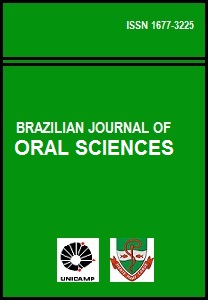Abstract
The surface roughness of prosthodontic materials is an important factor that influences the amount of microbial plaque accumulation, thereby increasing the risk of caries and periodontal inflammation of abutment or adjacent teeth. Few studies exist that have investigated the influence of disinfectant materials on the surface roughness of prosthodontic materials. The purpose of this study is to evaluate the roughness changes in metal-ceramic and IPS Empress 2 ceramic structures, finished by either manual-polishing or glazing, followed by immersion in 2% glutaraldehyde solution for either 30 minutes (disinfection procedure) and 10 hours (sterilization procedure). The study consisted of 26 metalceramic specimens and 26 Empress 2 specimens measuring 10 x 10 x 2 mm. One-half of each group of specimens was polished by using rotatory instruments and the other half was glazed in a glazing oven (subgroups). Afterwards, the specimens were submitted to sterilization and disinfection in 2% glutaraldehyde for either 30 minutes or 10 hours, respectively. 3 specimens from each group were sterilized in autoclave, and for control group, the initial measurement of each specimen before the disinfection and sterilization procedures was obtained. The surface roughness was determined by a Hommel Tester T-1000, using the mean arithmetic Ra as roughness parameter. The results were statistically analyzed using a 4-way analysis of variance (ANOVA) method for individual comparisons among the means and the Tukey test at a significance level of p<.05. The results showed that there were no statistically significant differences of roughness in both groups, after immersion in chemical solution and sterilization in autoclave (p<.05). The mean of ceramic materials ranged from .631mm to 1.687mm in surface roughness. There was a statistically significant difference only among final polishing of ceramics (F=19.00; p<.001) and in the interaction between polishing and material used (F=18.83; p<.001). No significant changes in surface roughness of tested ceramic materials occurred after completion of the disinfection and sterilization procedures used in this study. Clinical implications: Infection control procedures are indispensable steps before cementation of prostheses. Based on the results of this study, prosthodontic materials can be disinfected or sterilized without causing significant changes in surface roughness.References
Merchant AV. Prosthodontics and infection control – it’s a whole new ballgame. J Calif Dent Assoc. 1989; 17: 49-53.
Kahn RC, Lankaster MV, Kate WJ. The microbiologic crosscontamination of dental prostheses. J Prosthet Dent. 1982; 47: 556-9.
Powell GL., Runnells RD, Saxon BA, Whisenant BS. The presence and identification of organisms transmitted to dental laboratories. J Prosthet Dent. 1990; 64: 235-7.
McGowan MJ, Shimoda LM, Woolsey GD. Effects of hypochlorite on denture base metals during immersion for short-term sterilization. J Prosthet Dent. 1988; 60: 212-8.
Council on Scientific Affairs and Council on Dental Practice. Infection control recommendations for the dental office and the dental laboratory. J Am Dent Assoc. 1996; 127: 672-80.
Asad T, Watkinson AC, Hugget R. The effect of disinfection procedures on flexural properties of denture base acrylic resins. J Prosthet Dent. 1992; 68: 191-5.
McNeme SJ, von Gonten AS, Woolsey GD. Effects of laboratory disinfecting agents on color stability of denture acrylic resins. J Prosthet Dent. 1991; 66: 132-6.
Shen C, Javid NS, Colaizzi FA. The effect of glutaraldehyde base disinfectants on denture base resins. J Prosthet Dent. 1989; 61: 583-9.
Sposetti VJ, Shen C, Levin AC. The effect of topical fluoride application on porcelain restorations. J Prosthet Dent. 1986; 55: 677-82.
Wunderlich RC, Yaman P. In vitro effect of topical fluoride on dental porcelain. J Prosthet Dent. 1986; 55: 385-92.
Adamczyk E, Spiechowicz E. Plaque accumulation on crowns made of various materials. Int J Prosthodont. 1990; 3: 285- 91.
Bollen, ML, Lambrechts, P, Quirynen, M. Comparison of surface roughness of oral hard materials to the threshold surface roughness for bacterial plaque retention: A review of the literature. Dent Mater. 1997; 13: 258-69.
Whitehead SA, Shearer AC, Watts DC, Wilson NHF. Comparison of methods for measuring surface roughness surface of ceramic. J Oral Rehabil. 1995; 22: 421-7.
Nikawa H, Hamada T, Yamamoto T. Denture plaque – past and recent concerns. J Prosthet Dent. 1998; 26: 299-304.
Cannon RD, Nand AK, Jenkinson HF. Adherence of Candida albicans to human salivary components adsorbed to hydrxyapatite. Microbiol. 1995; 141: 213-9.
Hagihara Y, Kaminishi H, Cho T, Tanaka M, Kaita H. Degradation of human dentine collagen by an enzyme produced by the yeast Candida albicans. Arch Oral Biol. 1988; 33: 617-9.
Rams TE, Slots J. Candida biotypes in human adult periodontitis. Oral Microbiol Immunol. 1991; 6: 191-2.
Slots J, Ram TE, Listgarten MA. Yeasts, enteric rods and pseudomonas in the subgingival flora of severe adult periodontitis. Oral Microbiol Immunol. 1988; 3: 42-52.
Ma T, Johnson GH, Gordon GE. Effects of chemical disinfectant on the surface characteristics and color of denture resins. J Prosthet Dent. 1997; 77: 197-204.
Tsun MA, Glen HJ, Glenn EG. Effects of chemical disinfectants on surface characteristics and color of three fixed prosthodontic crows materials. J Prosthet Dent. 1999; 82: 600-7.
Kelly JR, Nishimura I, Campbell SD. Ceramics in dentistry: Historical roots and current perspectives. J Prosthet Dent. 1996; 75: 18-32.
Ward, MT, Tate WH, Powers JM. Surface roughness of opalescent porcelains after polishing. Oper Dent. 1990; 20: 106-10.
The Brazilian Journal of Oral Sciences uses the Creative Commons license (CC), thus preserving the integrity of the articles in an open access environment.

